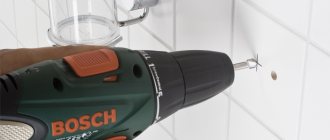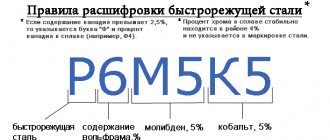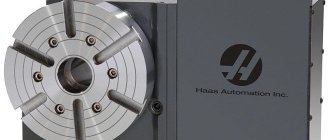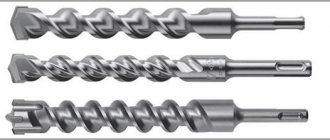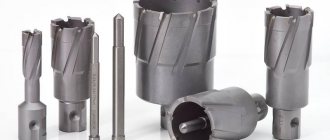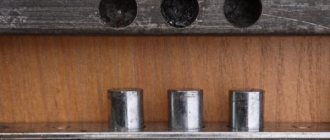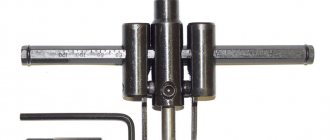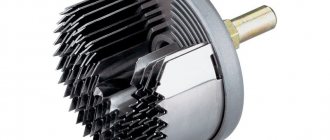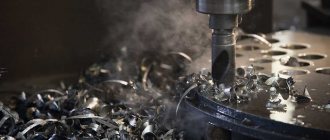Features of drilling tiles
Ceramic tiles have two qualities:
- fragility . Using the wrong tool or inappropriate drilling mode leads to chipping of the material and the appearance of chips on its surface;
- slippery surface . Most tiles are coated with a glaze that the drill glides over. Because of this, at the beginning of drilling it is necessary to use the techniques described below.
Briefly about the main thing
Porcelain tiles can be drilled with a Pobedit drill using the dry method, but it will quickly fail.
More holes can be made with diamond-coated tools. If you use coolant during operation, the crowns will last even longer.
The best option is ring or tubular drills. They handle 100-150 holes. But the minus in the duration of the task is largely due to the debris accumulating at the drilling site. It constantly needs to be removed. Also, to avoid cracking of the tiles, work should be done at low speeds.
The impact mode on a rotary hammer or drill is excluded in the case of porcelain stoneware. Because of it, chips appear and the risk of cracking of the decorative material increases.
Tool types
The following tools are suitable for making holes in tiles:
- hand drill . Its strengths are full control of rotation speed and lack of vibration. These advantages make a hand drill the most suitable tool for drilling ceramic tiles;
- electric drill . It is used in most cases, since hand drills are extremely rare on sale. A model with continuously adjustable chuck rotation speed is preferable: it is desirable that when drilling ceramics this parameter does not exceed 1000 rpm;
- screwdriver _ The power of this device is quite sufficient, because significant effort is not required to drill tiles. Compared to a drill, a screwdriver has an important advantage: there are models with batteries that allow you to work on sites without power supply;
- jigsaw _ Used to make large holes if there is no more suitable tool.
Diamond types of drills
Diamond drills for porcelain stoneware can be differentiated by type of base.
Distinctions by type of production - belonging to the diamond group:
- Galvanic finishing with diamond chips on the edges of the cutter. These drills are suitable for relatively soft rocks. This is often how drills are created in the shape of a cylinder. The disadvantage of galvanized products is their short service life. The devices fail after 5-6 holes are made. This negative side is offset by the inexpensive price, which makes it possible to buy them in multiple copies. When working with diamond crowns, you don’t need to worry too much about the enormous pressure, because it is reduced thanks to special slots at the ends of the tools.
- Sintering of diamond components onto a metal alloy sealed onto the working part of the tool. According to this production scheme, drills for long-term use are produced - annular and tubular types. Thanks to these nozzles, you can make many holes - over 100 pcs. The cutting plane of a tubular drill does not accommodate slots and appears as a complete circle. This makes it impossible to remove dust generated during the working process. At the same time, considerable pressure is exerted on the tile plane, which can cause cracks in it. Therefore, it is recommended to process tubular drills at low chuck speeds, sometimes raising the nozzle to clean the dust.
- Vacuum diffusion method of applying a diamond layer. It is used to make feathers and objects with cones. It does an excellent job of processing ultra-dense material. It is used when there is a need to drill holes d- 6, 8, 10 mm.
Varieties
There are several types of ceramic drills. Here is their comparative characteristics.
Spear-shaped
They have the following advantages:
- low cost: from 60 to 120 rubles;
- long service life.
These qualities make the spear-shaped drill one of the most popular when drilling holes in tiles with a diameter of up to 12 mm (the maximum for this drill).
The service life is greatly reduced when drilling porcelain stoneware - only enough for 4-5 holes. But taking into account the high cost of special drills for this material (300-500 rubles), drilling a small number of holes with two or three spear-shaped drills seems more profitable.
The profile and sharpening angle of the tool is designed exclusively for glass and ceramics. When you try to drill into brick or concrete, it quickly fails.
Pobeditovye
The winner is an alloy of tungsten and cobalt developed in the USSR, characterized by high hardness and at the same time affordable cost. Pobedite drills are quite popular as they have the optimal combination of price and durability.
Drill with pobedite tip
Carbide
A characteristic feature of this drill is the one-sided sharpening of the cutting part at an acute angle. Thanks to this, penetration into fragile materials such as ceramic tiles and natural stone occurs easily and without cracking. Carbide drills are produced with a diameter of no more than 12 mm.
Diamond coated
This variety is more suitable for professionals who need to drill tiles constantly and in large quantities, it is expensive, but:
- easily copes with even very hard materials: diamond is stronger than any other material in nature;
- has an increased resource;
- makes holes with very smooth edges, since the material is not cut, but crushed by sputtering crystals.
According to the method of fixing diamond coating, drills are divided into three types:
- with diamond chips attached to solder . This is the most affordable variety, but it loses its coating relatively quickly, especially when overheated (the solder softens);
- with mechanical fixation . Diamond chips are fused into the edge of the drill, heated by high-frequency currents to a state of plasticity. The tool is resistant to overheating and loses its coating much more easily, so it lasts longer. At the same time, its cost, although higher than the previous variety, is quite affordable;
- with laser soldering. The most expensive and durable drills. Typically used in industry.
Circular "ballerina"
The tool is similar to a compass: one “leg” is a centering drill, the second is set aside and equipped with a cutter.
There are models with two cutting “legs”. The distance between the legs, that is, the radius of the hole being made, is adjusted with a hex key.
The minimum value is 15 mm, the maximum is 45 mm. Accordingly, the “ballerina” allows you to drill holes with a diameter of 30 to 90 mm.
This type of drill is convenient if holes have to be made from time to time and of different diameters. For permanent work, it is better to purchase a set of crowns (cylindrical drills): they leave a smooth edge. After the “ballerina”, the edge of the hole has to be leveled with sandpaper or a file.
Feather
A characteristic feature of a feather drill is a pointed cone protruding in the center of the cutting edge. It allows you to accurately position the drill and at the same time “catch” on the slippery glazed surface.
There is no need to pre-core the tiles. The maximum diameter of the pen drill is 30 mm.
Universal
Manufactured from high carbon steel. They are sharpened in a special way, allowing them to process a wide range of materials.
Video description
How to properly drill porcelain tiles with a diamond crown is described in the video:
Work resource
Another important criterion for determining what is better for drilling porcelain stoneware is the working resource. To form several holes, it is enough to use a Pobedit drill or drill, or a diamond-coated crown. They are relatively easy to work with and the cost is quite low.
For large-scale work or professional activities, the choice should be made in favor of tubular analogues. Here, drilling takes significantly more time, plus periodic removal of debris and cooling of the equipment. But the performance will be significant without damaging or wearing off the cutting edge.
Crowns
A crown or cutter is a cylinder-shaped drill for making large-diameter holes. Base material: tool steel. At one end the cutting elements are fixed (various materials are used), at the other there is a shank for fastening in the drill chuck.
Based on their design, crowns are divided into two types:
- with centering drill: used for working with hand tools;
- without center drill: for permanent installations.
A crown without a centering drill, attached to a hand drill, “walks” on the tile when trying to drill. For drilling tiles, only sprayed cutters are used.
The toothed (carbide) varieties are designed for impact drilling and are therefore not suitable for fragile ceramics. Based on the coating material, cutters are divided into two types: diamond-coated and tungsten carbide.
The advantage of crowns is the high quality of drilling. The edge of the hole does not need to be trimmed, as after the “ballerina”.
Diamond coated
Like a diamond drill, this tool is more often used by professionals. It has a significant resource, but is expensive.
Crowns get hotter than drills, which is why diamond-coated tools are divided into two types:
- for wet drilling . Here the diamond chips are fixed in the least reliable way - on solder. When heated, it softens and the crown loses its coating. To avoid this, water must be supplied to the work area. Wet drilling cutters have an important advantage: after their service life has expired, the cutting part can be replaced, so there is no need to purchase a new crown;
- for dry cutting. Expensive crowns with coating fixed by laser soldering, immune to overheating. The tool is divided into segments by slots for effective heat dissipation. The cutting part cannot be restored; after its service life is exhausted, you have to buy a new cutter.
Tungsten carbide
The cheapest, but also the least durable variety. Typically, a tungsten carbide cutter is purchased for one-time work.
Additional selection criteria
It’s clear how to drill a hole in porcelain stoneware relative to the cutting element. However, this is not the only thing to consider when choosing a tool. It is also necessary to consider the required result parameters and the number of drillings performed.
Size
Before drilling porcelain tiles, precise markings are carried out. After all, here errors are sometimes unacceptable. Here, the diameter of the hole is important for choosing a drill. Manufacturers offer equipment of almost any size, but 6-12 mm in 2 mm increments are in great demand.
Pobedite drill Source cloudinary.com
The range of permissible sizes of diamond bits is noticeably wider than that of drills. It is 8-150 mm. More often, craftsmen use equipment from 20 to 100 mm. This can be explained by the parameters of pipes and boxes for utilities.
It is worth noting one point regarding the marking of drilling products. The diameter of the tooling can be specified in both mm and inches. If it is necessary to form precise holes, this fact must be taken into account.
When deciding what to drill into porcelain tiles, you can follow the recommendations of the experts. They touch small or large holes.
| Small diameter | Large diameter |
| Small sizes include seats for dowels or dowels for screws/nails. Here, the best solution would be a diamond drill for a hammer drill and ring gear. | To form holes for utility lines, only diamond core bits can be used. |
It is worth noting that tubular type equipment is subject to work with coolant (water). This rule prevents the tool from overheating due to additional friction against debris. And drills refer to drills for porcelain stoneware for dry drilling. In the case of crowns, craftsmen recommend using a centering rod for a novice worker. It is designed to adjust the position of the cylinder, eliminating unwanted sliding along the surface of the decorative canvas.
Crown with centering drill Source ozone.ru
For large diameter holes
Large diameter holes required for installing sockets and conducting communications are made using crowns and circular ballerina drills.
If you need a hole with a larger diameter than the existing tool, proceed as follows:
- the contours of the opening are drawn with a marker;
- make a hole anywhere on the circle with a thin drill;
- thread a jigsaw thread into the hole. For cutting ceramics, a tungsten-coated version is used;
- fix the thread in a jigsaw and cut a hole along the contour.
How to work with a “ballerina”?
Let's see how to drill ceramic tiles with this tool. An electric drill without impact function is required for operation. The drilling process is carried out strictly at low speeds. Also, during the work, do not press too hard, pressing the tool against the surface of the tile.
It is most convenient to make holes in ceramics when they have not yet been laid. If you drill from both sides, you can get the best result.
But even with the correct use of drills of this type, the walls of the hole made will never be perfectly smooth. If the tile is located in an open area, the hole will definitely require modification. Well, if it is under the bathtub or under the sink, then uneven edges do not have such a serious significance.
Can I use a drill bit to drill into concrete?
All tile drills, except universal ones and crowns, are not designed for concrete and immediately become dull upon contact with it. Therefore, after drilling the tiles, the equipment must be replaced with a concrete drill.
Crowns drill concrete. Moreover, diamond ones, unlike tungsten carbide, also cut reinforcement. If you use a tungsten carbide crown, you should first determine the position of the reinforcement in the wall with a special detector and choose the installation location so as not to bump into it.
The segment attached to the end of the crown, onto which diamond coating is applied, is called a matrix; based on the material of the matrix, they are divided into types:
- soft (letter “M” in the marking). Designed for especially durable concrete, self-cleaning from concrete chips and dust;
- medium-hard (letter “C” in the marking). Designed for ordinary concrete with reinforcement;
- solid (letter “T” in the marking). They are used for processing high-grade concrete, drilling is carried out at low speeds.
Features of porcelain stoneware
Porcelain tiles have become often used in modern construction. It has found application as a finishing material, and also in the creation of ventilation facades.
You can pay attention to several inherent features of the material:
- Abrasion resistance. This is achieved due to the properties of the monolith, where all the ingredients are tightly connected;
- Uniform and unique design. The plane of the tile can resemble different structures and raw materials;
- Great strength. The material is designed to withstand heavy loads and temperature changes. This makes it possible to use it for external and internal work;
- Low water absorption and non-slip.
It is necessary to pay attention in particular to the strength of the material, because the quality of processing depends on it. There are several options for cutting, because this process is much easier to achieve.
To drill holes, only a special drill designed for porcelain stoneware is used. It is important to note that not all tools are suitable for cutting through such hard material. Often drills cannot withstand the resulting load, which makes it possible to use them only a few times.
Drilling technology
A hole in a ceramic tile is made as follows:
- switch the drill to non-impact mode and install a drill of the required diameter in the chuck. The hole in the tile should be made with a larger diameter than in concrete, otherwise when drilling concrete in the hammer drill mode, the tile may crack;
- if the tile is not yet glued, it is soaked for 40-50 minutes. (except porcelain stoneware);
- markings are applied. The location is selected so that the edge of the hole in relation to the edge of the tile is at a distance of at least 15 mm;
- carefully, avoiding significant effort, begin to drill.
Preliminary measures are taken to prevent the drill from slipping; the following techniques are used:
- scratch the glaze with the corner of a file or a hardened screw;
- stick paper tape (also known as crepe tape or masking tape) or electrical tape;
- mark with a clerical proofreader;
- drill through a jig - a block with a hole of the same diameter, pressed tightly to the tile.
Overheating of ceramics in the drilling zone leads to the appearance of cracks. To avoid this problem, the drill is periodically cooled. Having drilled through the tiles, install a concrete drill bit in the drill chuck.
The tiles that have not yet been installed are drilled in the same way as the glued ones - from the front side. The reason is that when the tool comes out of the material, chips often form.
Recommendations from drilling experts
The problem often arises of how to drill a hole in porcelain stoneware for a toilet or socket yourself. The solution is to carry out work exclusively in rotational mode. That is, the best option would be to use a simple drill. The impact or impact effect will certainly lead to cracking of the “granite” coating.
Hammerless drill Source voltra.by
Another point is adjusting the number of revolutions. This is especially important when deciding how to drill porcelain stoneware on a wall/floor using ring-shaped equipment. They can only be operated at low rotation speeds.
Beginning builders often make the mistake of drilling at a deviation from a right angle. The drill must be positioned strictly perpendicular to the plane being processed. To comply with the latter, you can use a special frame-retainer for a drill or hammer drill.
Drill stand Source allegroimg.com
How to work correctly?
Let's look at safe ways to drill ceramic tiles. There are two methods - manual and using a drilling machine.
When choosing the manual method, it is necessary to reduce the clamping force to a minimum. This will help maintain the integrity of the tile. Work should only be carried out at low speeds. The smaller they are, the less backlash and vibration.
Do not overheat the area where the hole will be. This can cause the ceramic tiles to crack. Experts recommend cooling drill bits for glass and ceramic tiles, and also pouring water on the surface of the material.
The main difficulty in making holes lies in the topmost layer, which is covered with glaze. Due to the strong smoothness, the drill moves away from the intended place. Several methods can be used to accurately position the drill at the desired point. So, you should scratch out the conical recess with a hardened self-tapping screw or the sharp edge of a file. You can achieve the same result by sticking masking tape or adhesive tape on the surface of the tile.
This will prevent the Victory bit from slipping during operation. You can mark the required point with a stationery proofreader.
Measures to protect the material from chips and cracks
When dealing with questions of how to drill tiles, we must not forget about precautions during work, thanks to which it will be possible to avoid deformation and complete destruction of the finishing material. First of all, to prevent the tile from cracking, it must first be soaked in plain water for 1 hour. If there is not enough time for such a solution, you can moisten the area where the holes are being drilled with a spray bottle.
To make it easier to start drilling large holes, you can cut out a stencil from fiberboard or plywood, then press it tightly against the tile to start drilling.
It is quite possible to reduce the likelihood of cracks if you step back at least 15 mm from the edge of the ceramic tile to the cutout. It’s better to calculate the installation point of the socket/shelf so that the hole for the fastening element is located on the connecting seam.
